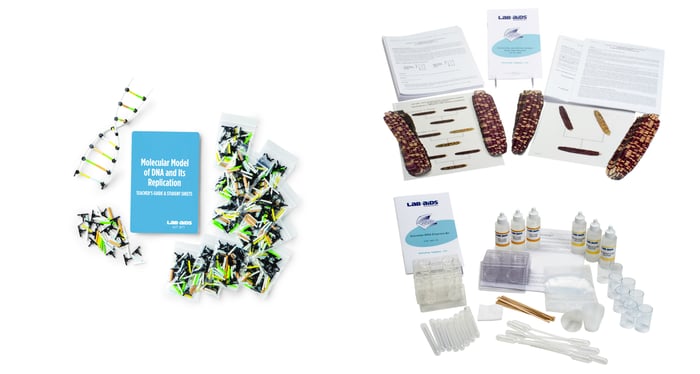Genetics Bundle 1

DNA Extraction and Collection: This lab activity allows students to easily extract and observe deoxyribonucleic acid (DNA) found in plant cells. They separate and spool the DNA so they can observe some of DNA’s physical properties. Students gain an appreciation and firsthand experience of the DNA structure. This lab activity comes with everything needed to perform the lab except the fruit and can be completed in one class period.
Investigating and Applying Genetics: Corn Students build their understanding of selective breeding for desired traits in crops such as corn. They investigate the outcomes of crosses of hybrid and dihybrid corn plants for two unlinked genetic traits: corn kernel color and sweetness. They use Punnett squares to predict the ratio of phenotypes that will be produced by different crosses and analyze the actual ratio of phenotypes of the second generation offspring. A reading describes traditional selective breeding and modern genetic engineering approaches to improving crops to improving crops. This kit is complete for 32 students and is reusable.
DNA Modeling: Molecular Structure & Replication: The two activities in this kit introduce students to the structure of the DNA molecule and how its structure allows it to replicate. Using a unique Lab-Aids modeling set, students first build an 8-rung DNA double helix and learn the base-pairing rule. Then starting with a 4-rung segment, they unzip the ladder and create two identical 4-rung strands by adding in new base pairs and sugar-phosphate groups.
Enjoy savings off of list price with this bundle.
Details at a Glance
- 4-7 Days | 4-7 ~50 minute class periods
- 4 Activities
- Accommodates 1 class, with 40 groups of 38 students
- Consumables service 32 students
- Meets our criteria for supporting literacy
Scientific Concepts
•Plant cells are surrounded by the cell wall, a tough cellulose outer barrier.
•All cells have a flexible barrier, the cell membrane, that encases all components of the cell (except the cell wall.)
•The nucleus of a cell, one of a cell’s organelles, contains the DNA and is encased by a separate flexible nuclear membrane.
•DNA is soluble in water, but not in ethanol.
•Cells store and use information in the form of genes that determine
their traits and guide their functions.
•Cells typically contain two copies (alleles) of each gene. This explains how variations that are hidden in one generation can be expressed in the next.
•Each parent contributes one allele for each gene to its offspring.
•DNA molecules have a “twisted ladder” double helix structure.
•Each “ladder rung” consists of a nitrogen base pair (single-ring pyrimidine linked to double-ring purine).
•The order of these base pair “rungs” determines the genetic code of every living thing.
•DNA molecules replicate by “zipping apart” where the weak hydrogen bonds connect the nitrogen bases.
•Models help scientists visualize and understand many concepts and processes.
Key Vocabulary: cell membrane, cell wall, deoxyribose nucleic acid (DNA), lysate, lysis, nuclear membrane, adenine, double helix, hydrogen bond, replication, cytosine, guanine, purine, thymine, DNA, hereditary, pyrimidine
Guides & Student Sheets
Our kits and modules provide you with everything you need so you can open, review, and teach the material confidently the next day.
- Comprehensive Teacher Guide with background information, detailed instruction, example data and answers
- Student Sheets with age appropriate background information, full procedure(s), and analysis items
- Materials necessary for the investigation (beyond common classroom items)
- Safety Data Sheets
